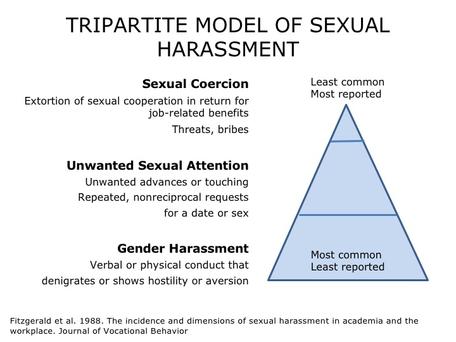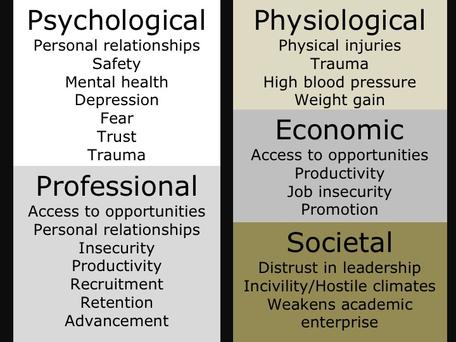Disrupting the Culture of Silence and 2017 and Review and Stepnick
What is Harassment, Bullying and Discrimination?
Everybody deserves the right to a learning and piece of work environment free of bigotry, harassment and bullying.
Jump downwards to: Harassment | Bullying | Research | More Reading
The American Geophysical Union adopted in 2016 a Scientific Integrity and Professional Ethics policy that includes a new code of conduct that broadens the definition of professional misconduct to include discrimination, sexual harassment, and bullying and includes the following statement:
AGU members work to maintain an environment that allows science and scientific careers to flourish through respectful, inclusive, and equitable treatment of others. As a statement of principle, AGU rejects discrimination and harassment past whatsoever means, based on factors such as ethnic or national origin, race, faith, citizenship, language, political or other stance, sex, gender identity, sexual orientation, inability, physical appearance, age, or economical form. In add-on, AGU opposes all forms of bullying including threatening, humiliating, coercive, or intimidating conduct that causes harm to, interferes with, or sabotages scientific action and careers. Discrimination, harassment (in any form), and bullying create a hostile environment that reduces the quality, integrity, and pace of the advancement of science past marginalizing individuals and communities. It too damages productivity and career advancement, and prevents the healthy exchange of ideas. Nosotros affirm that discrimination, harassment (including sexual harassment), or bullying in whatsoever scientific or learning environment is unacceptable, and constitutes scientific misconduct under the AGU Scientific Integrity and Professional person Ethics Policy.
Discrimination
The AGU defines discrimination every bit: unequal or unfair treatment in professional opportunities, teaching, benefits, evaluation, and employment (such equally hiring, termination, promotion, bounty) besides as retaliation and various types of harassment. Discriminatory practices can exist explicit or implicit, intentional, or unconscious.
Harassment
The U.S. Equal Employment Opportunity Commission (EEOC) defines:
"Harassment is a form of employment discrimination that violates Title 7 of the Ceremonious Rights Act of 1964, the Age Discrimination in Employment Act of 1967, (ADEA), and the Americans with Disabilities Act of 1990, (ADA). Harassment is unwelcome conduct that is based on race, color, faith, sex activity (including pregnancy), national origin, age (40 or older), inability or genetic information. Harassment becomes unlawful where ane) enduring the offensive acquit becomes a condition of continued employment, or 2) the deport is severe or pervasive enough to create a work environs that a reasonable person would consider intimidating, hostile, or calumniating. Anti-discrimination laws also prohibit harassment against individuals in retaliation for filing a discrimination charge, testifying, or participating in any way in an investigation, proceeding, or lawsuit under these laws; or opposing employment practices that they reasonably believe discriminate confronting individuals, in violation of these laws."

"Sexual harassment is unwelcome sexual advances, requests for sexual favors, and other verbal or physical harassment of a sexual nature."
"Sex discrimination involves treating someone (an bidder or employee) unfavorably because of that person's sex. Discrimination against an private considering of gender identity, including transgender status, or because of sexual orientation is discrimination in violation of Title 7."
The AGU further defines harassment as a single intense and astringent act, or of multiple persistent or pervasive acts, which are unwanted, unwelcome, demeaning, abusive, or offensive. These acts may include epithets, slurs, or negative stereotyping based on gender, race, sexual identity, or other categories, every bit protected by U.S. federal police. Also included are threatening, intimidating, or hostile acts; denigrating jokes and displays; or circulation of written or graphic material that denigrates or shows hostility or disfavor toward an individual or a group.
Bullying
Bullying has traditionally addressed interactions among school-aged children but recent research shows adults too face bullying behavior in the workplace. Bullying is whatsoever unwanted aggressive beliefs(south) that involves an observed or perceived power imbalance and is repeated multiple times or is highly probable to be repeated. Bullying may inflict impairment or distress including concrete, psychological, social, or educational impairment. Bullying can be directly or indirect, verbal, social (relational) or physical. In that location is no federal anti-bullying constabulary just some states do have anti-bullying legislation. When bullying is too harassment, it does pause federal law.
The AGU defines bullying equally the use of force, threat, or compulsion to abuse, intimidate, or aggressively dominate others in the professional environment that involves a real or perceived power imbalance. These actions can include calumniating criticism, humiliation, the spreading of rumors, physical and exact attacks, isolation, undermining, and professional exclusion of individuals through any means.
The behaviors described to a higher place contribute to creating hostile climates and interfere with people'south power to acquire and work when they occur in educational and professional settings.

Harassment has psychological, physiological, professional, economic and societal effects.
Research on the effects of harassment and hostile climates:
- Cortina, 50. M., South. Swan, L. F. Fitzgerald and C. Waldo. 1998. Sexual harassment and assault: Chilling the climate for women in academia. Psychology of Women Quarterly 22: 419:441.
- Fitzgerald, L.F., F. Drasgow, C.50. Hulin, One thousand. Gelfand and 5.J. Magley. 1997. Antecedents and consequences of sexual harassment in organizations: A test of an integrated model. Journal of Applied Psychology 82: 578-589.
- Carr, J.Z., Schmidt, A.1000., Ford, J.1000., DeShon, R.P., 2003. Climate perceptions matter: A meta-analytic path analysis relating molar climate, cognitive and affective states, and individual level work outcomes. Journal of Applied Psychology 88: 605-619.
- Davis, M.E., Vakalahi, H.F.O., Scales, R., 2015. Women of color in the academy, In: De Welde, K., Stepnick, A. (Eds.), Disrupting the Culture of Silence: Confronting Gender Inequality and Making Modify in Higher Educational activity. Stylus Publishing, Sterling, Virginia, pp. 265-277.
- Willness, C.R., Steel, P., Lee, G., 2007. A Meta-Analysis of the antecedents and consequences of workplace sexual harassment. Personnel Psychology threescore, 127-162.
- Clancy, Thousand.B.H., Lee, Thou.M.N., Rodgers, East.M. and Riche, C. 2017. Double jeopardy in astronomy and planetary science: Women of color confront greater risks of gendered and racial harassment. Periodical of Geophysical Research: Planets 122: 1610-1623.
- Gibney, Due east. 2017 Excluded, intimidated and harassed: LGBT physicists face discrimination. Nature x.1038/nature.2016.19614
- New survey highlights gender, racial harassment in astronomy and planetary science July 10, 2017
More reading on the furnishings of harassment and hostile climates:
- What happens when sex harassment disrupts victims academic careers past Nell Gluckman in The Chronicle of College Pedagogy, December half dozen, 2017
- The insidious economic impact of sexual harassment past Nilofer Merchant in Harvard Business Review, November 29, 2017
Source: https://serc.carleton.edu/advancegeo/resources/definitions.html